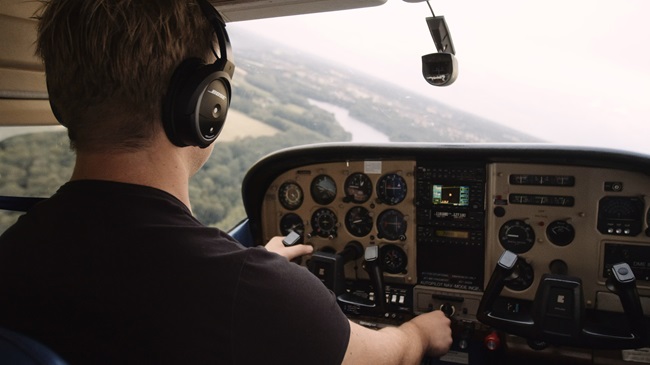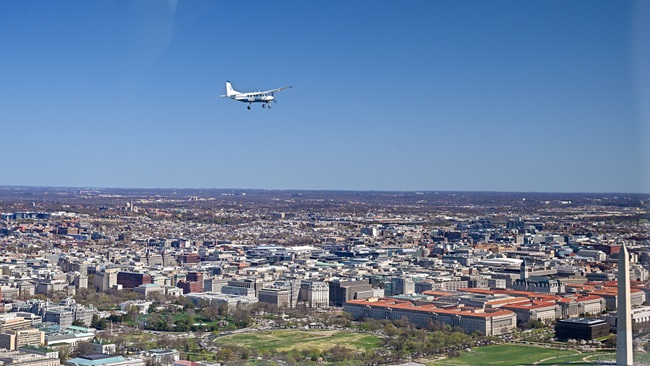Pilot Briefing: New York to Tokyo in two hours
Bizjet concept aims to shatter sound barrier in near-silence
Test Pilot
By Barry Schiff
- What was the first production airplane to incorporate the remarkably successful and popular Pratt & Whitney PT6 turboprop engine?
- What current manufacturer of popular automobiles was the first manufacturer of production turbojet engines?
- From reader John Schmidt: Part 23 of the Federal Aviation Regulations specifies that it must be possible to safely land a certified airplane without using
a. ailerons.
b. the elevator(s).
c. pitch trim.
d. the rudder(s). - The landing deck of an aircraft carrier is angled 15 degrees left of the ship’s centerline, so that the relative wind created by the ship always creates a right crosswind component for landing pilots. When the surface wind is southerly and equal to the ship’s speed, what must the ship’s heading be so that the pilot can land without a crosswind? (A wind-triangle computer is not required.)
- How did the U.S. Army Air Corps save Hilo, Hawaii, when that town was threatened by the eruption of the Mokuaweoweo Volcano in 1935?
- True or False? An airplane in a coordinated turn at a constant bank angle and maintaining a constant altitude at a fixed airspeed is not accelerating.
- From reader Howie Lowden: The first aircraft to complete a transatlantic flight was one of three U.S. Navy Curtiss NC flying boats, NC-4, that completed the journey on May 27, 1919. What was the primary method of navigation used during that flight?
- The most powerful piston engine ever built for an aircraft was manufactured by
a. Lycoming.
b. Packard.
c. Pratt & Whitney.
d. Wright.
PEOPLE
Fly like Superman
By Alton K. Marsh
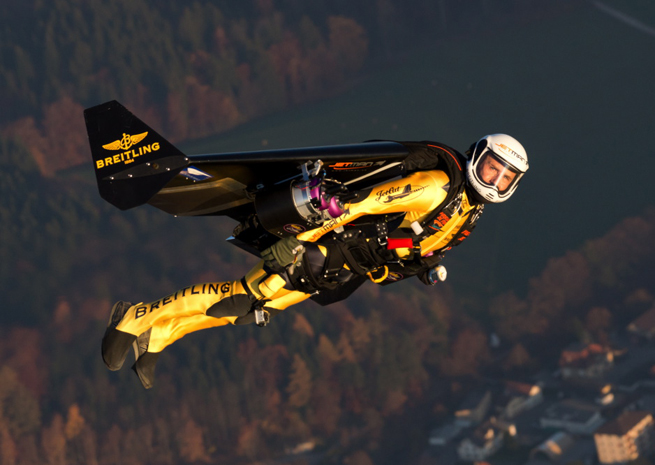
Jetman Yves Rossy will tumble backward off the skid of a helicopter at not only EAA AirVenture 2013 but the Reno, Nevada, National Championship Air Races and Air Show later in the year. He’ll then fly like Superman with the aid of a wing strapped to his back and four jet engines designed for model airplanes, using only his feet, arms, and hands to control his flight path. Rossy is a Swiss airline pilot and inventor. He can do a loop, although there are no details on what he might perform at Oshkosh and Reno. He has previously flown what was deemed by his publicist as a “private” demonstration above the Grand Canyon in 2011, but it was anything but private. Media types were ready and waiting.
Rossy uses German-made Jetcat P200 model aircraft engines—to the horror of the U.S. distributor, but to the delight of the German manufacturer that has signed on as one of his sponsors. He has appeared on the Late Show with David Letterman where Letterman inquired if he could become a sponsor. So far the only name on his wing has been Breitling, the luxury watch manufacturer. Rossy has flown in formation with a Douglas DC–3 carrying Breitling employees.
Email [email protected].
Flight school forms simulator club
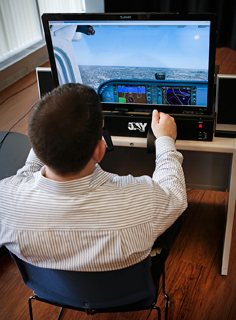 Imagine having yearlong access to a flight school’s simulator for $120. That’s soon to be a reality for pilots near Lock Haven, Pennsylvania, thanks to a new club formed by local flight school AvSport. Users will pay one fee and get unlimited access to an AOPA Jay by Redbird for a year. Current AvSport students will have free access.
Imagine having yearlong access to a flight school’s simulator for $120. That’s soon to be a reality for pilots near Lock Haven, Pennsylvania, thanks to a new club formed by local flight school AvSport. Users will pay one fee and get unlimited access to an AOPA Jay by Redbird for a year. Current AvSport students will have free access.
School owner Dr. Paul Shuch said students will use the Jay as part of his integrated sport pilot and private pilot upgrade curriculums. He envisions certificated pilot members will use the available scenarios as a form of self-guided learning. “Certificated pilots joining the simulator club will be given a catalog of available scenarios from which to select. They can fly those, or just go into free-flight mode, exploring and experimenting,” he said.
Shuch said he chose the Jay because of its price point, which at $2,490 falls between home systems and those approved by the FAA for currency. He also was drawn to the idea of scenarios, whether he creates them or they are already on the device from AOPA, EAA, and others.
“Without a published curriculum that tells the student what he or she will be doing in each lesson, what the completion standards are, and what homework will help the student to prepare for that lesson, they would find themselves just wandering around the sky burning avgas, helping the instructor to build hours toward his or her own airline career—maybe having fun, but making very little educational headway. Without scenarios, simulator training is just the same, except we’re not burning avgas,” he said. Shuch is currently accepting charter members that will have privileges through the end of 2014, as well as a few select lifetime members (see “This Bird Really Flies,” April 2013 AOPA Pilot or visit the website.—Ian J. Twombly
Test Pilot answers
- The PT6 first flew on a Beech 18 (Twin Beech) test aircraft in 1961, but the first production engines (rated at 500 shp) were delivered to Beech Aircraft in 1963 for use on the 1965 Beech King Air 90.
- Germany’s BMW (Bavarian Motor Works) also was a major manufacturer of reciprocating engines during both world wars.
- (b) Such a landing must be demonstrated during certification flight testing. Do not try this at home.
- 210 degrees. This need not be computed aboard ship, however. The carrier can simply be turned until the “wind sock” parallels the canted deck. The deck in this case provides a landing direction of 195 degrees.
- Keystone light bombers (twin-engine biplanes) dropped high explosives so as to divert the approaching river of lava and molten rock.
- False. A turning airplane is accelerated by the horizontal component of wing lift (the turning force). Otherwise the aircraft would continue in a straight line. An airplane is accelerating—it is in accelerated flight—whenever the load factor is other than +1 G.
- Lt. Cmdr. A.C. Read and his crew followed a string of “station ships” (mostly destroyers) that were highly illuminated at night and spaced at 50-mile intervals between Newfoundland and the Azores. (Sailors aboard those ships also fired bright star shells into the sky as the aircraft approached.) A string of additional warships led the way from the Azores to Lisbon, Portugal.
- (a) Lycoming’s XR-7755 was a 36-cylinder, water-cooled radial engine that developed 5,000 horsepower, weighed 6,050 pounds, and had a displacement of 7,750 cubic inches. It was never used on a production airplane.
FLY-OUTS
Santa Fe
Eclectic town is a work of art
By Alyssa J. Miller
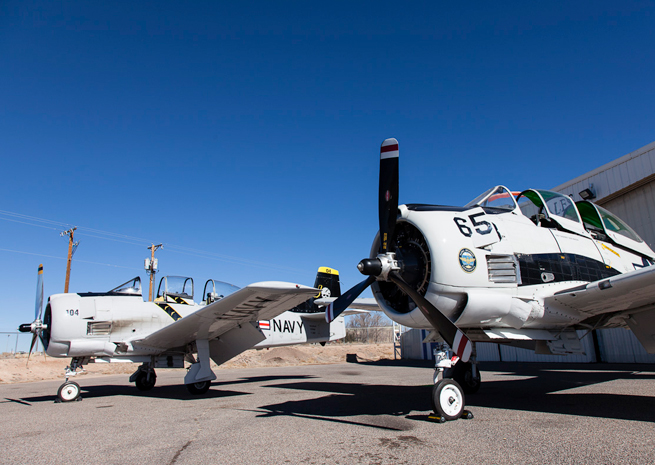
The Jemez and Sangre de Cristo mountains paint a breathtaking backdrop for pilots landing at New Mexico’s Santa Fe Municipal Airport on the high desert plateau. Works of art appealing to pilots’ hearts—from fully operational piston and jet warbirds available for training flights to brand-new fighters stopping for fuel en route for delivery—flit to and fro at the busy airport, with general aviation, corporate, and airline traffic adding to the mix. Whimsical statues at the Spanish-style terminal and FBO offer a hint of what’s to come in town.
Santa Fe Air Center offers a courtesy car for two hours (Enterprise car rentals are available), giving visitors some time to sightsee. Leaving the airport, Santa Fe exudes eclectic tastes of art and culture. Just give it a chance—a junkyard located beside the airport entrance belies the town’s charm. The short drive to Santa Fe takes tourists by a Buddhist temple and into the heart of the town where the Cathedral Basilica of St. Francis of Assisi rises. Downtown features artwork and statues at every turn, from elaborately painted parking garage posts to building facades. Two-story shops, selling everything from Native American to Spanish to modern art, jewelry, and clothing, are fashioned with flair; restaurants boast interior courtyards to allow visitors to bask in Santa Fe’s 300-plus days of VFR weather a year.
Whether dining in the airport restaurant, downtown at the popular New Mexican eatery The Shed, or at a steakhouse, be prepared to eat some chiles—they come with everything. $100 hamburger with chiles. Chile rellenos. Peanut brittle, yes, with chiles in it.
 In July and August, the Santa Fe Opera Festival season will be in full swing. Year-round, the area offers outdoor activities in the Sangre de Cristo and Jemez mountains. Only 30 miles away is Los Alamos, the birthplace of the atomic bomb. For adventurers, there’s also the chance to strike it rich: Millionaire Forrest Fenn breathed new life into Santa Fe this year by releasing clues to news media and in a memoir, The Thrill of the Chase, as to the location of a supposed treasure chest worth a pretty penny that he buried in the nearby mountains. But those who visit will find that Santa Fe is the real treasure, a true work of art to be savored.
In July and August, the Santa Fe Opera Festival season will be in full swing. Year-round, the area offers outdoor activities in the Sangre de Cristo and Jemez mountains. Only 30 miles away is Los Alamos, the birthplace of the atomic bomb. For adventurers, there’s also the chance to strike it rich: Millionaire Forrest Fenn breathed new life into Santa Fe this year by releasing clues to news media and in a memoir, The Thrill of the Chase, as to the location of a supposed treasure chest worth a pretty penny that he buried in the nearby mountains. But those who visit will find that Santa Fe is the real treasure, a true work of art to be savored.
Santa Fe Municipal Airport (SAF)
Santa Fe, New Mexico
505-955-2900
Rental cars: www.aopa.org/cars
866-315-9155
Email [email protected].
Fly-outs made possible by Enterprise Rent-A-Car.
Solar Impulse flying U.S. demonstration flight
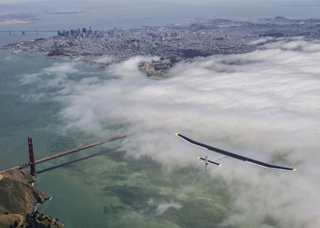 The solar-powered Solar Impulse aircraft is flying across the United States on no fuel at all, using solar cells to charge batteries by day and slowly floating down from higher altitudes by night.
The solar-powered Solar Impulse aircraft is flying across the United States on no fuel at all, using solar cells to charge batteries by day and slowly floating down from higher altitudes by night.
The flight is aimed at focusing awareness on alternative power sources. It has made several long-distance flights, including one from Switzerland, where it is based, to Africa and back.
The aircraft, a project launched in 2003, completed the world’s first solar 26-hour day and night flight in 2010. It flew to Brussels and Paris in 2011.
The Solar Impulse had flown from California to Phoenix as this was written, with next stops planned in Dallas; St. Louis; Washington, D.C.; and finally New York City.
EVENTS
Red Tails reaching out
Traveling exhibit takes Tuskegee Airmen story to children
By Jill W. Tallman
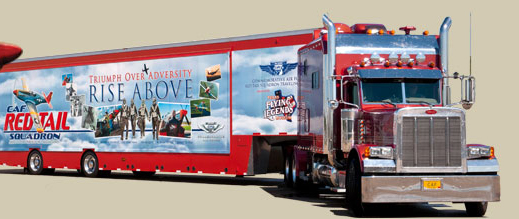
Airshows are a great way to showcase aviation to the nonflying public—so long as the public comes to the airshows. When you have an important story to tell, however, sometimes you need to go directly to your audience.
That’s why the Commemorative Air Force (CAF) Red Tail Squadron created the Rise Above exhibit to tell the story of the Tuskegee Airmen. Rise Above is not simply a static P–51—though that impressive airplane plays a starring role in an aviation setting. A key part of the exhibit is a short-form film that puts its viewers in the back seat of that P–51. The film is viewed in a 35-seat theater housed in a 53-foot trailer that is trucked directly to schools and other venues.
The story on film
Adam White, director of documentaries Flight of the Red Tail, Red Tail Reborn, and The Restorers, was in the director’s chair for this effort as well. “We try to remember what normal people don’t know,” he said. “Ninety percent of African-Americans don’t know about the Tuskegee Airmen. You have to hit them with the very clear facts: that these airmen volunteered to save the world”—and then encountered prejudice when they returned home to the United States. Two versions were shot; the longer version for schools features a young student who learns that a new friend fought in a war as a pilot, and that the man had to overcome obstacles to reach his goal. Tuskegee Airmen Col. Charles E. McGee appears as himself, which White said added even more impact to the story: “Here’s the guy who was asked to sit in the back of the bus.”

White filmed three P–51s from a variety of angles to give the film its needed authentic feel. “You couldn’t shoot these on a green screen,” he said. An aspect ratio of 7:1 allowed the filmmaker to use more parts of the screen and do more to keep the viewpoint realistic. “This movie was made for one theater only,” White said. “It will not be seen on DVD or iPad.” The theater employs a custom-built 163-degree panoramic screen designed by a company that specializes in planetarium shows.
White says the Rise Above message can be especially important for youth who may be at risk, because they can see firsthand that the Tuskegee Airmen overcame obstacles that seemed insurmountable. “They were told they didn’t have the physical, moral, or mental capacity to operate those machines,” he says.
The airplane and its pilot
The distinctive P–51C Tuskegee Airmen can be seen when the exhibit is on display at airshows, fly-ins, and other aviation venues.
On a May afternoon in 2012, Tuskegee Airmen sat outside the Rise Above trailer at Culpeper Regional Airport in Virginia. The exhibit had just finished a three-day run at Andrews Air Force Base, and plans were to take the program to public schools in Virginia. Unfortunately, a week of mandatory testing had left no room in the schedule for Culpeper’s students to view the film. The show would go on, however, for about two dozen home-schooled children and Boy Scouts who were coming out to the airport.
White, producer Kara Martinelli, and a group of CAF volunteers were on their hands and knees assembling the screen. A hard drive that had been shipped overnight had been damaged, and a new hard drive must be made operational before the students arrive.
 Tuskegee Airmen’s pilot, Doug Rozendaal, recalled attending Canada’s World Fair in 1964 as a 10-year-old, and viewing a 360-degree panoramic film in which the audience got to “fly” in the open cockpit of a biplane. “I spent the next 40 years” with airplanes, he said of that film’s impact. He hopes Rise Above will have the same type of effect on this generation. “If the objective is to cause people to realize their hopes and opportunities,” he said, “it has to rise to the level of an experience.”
Tuskegee Airmen’s pilot, Doug Rozendaal, recalled attending Canada’s World Fair in 1964 as a 10-year-old, and viewing a 360-degree panoramic film in which the audience got to “fly” in the open cockpit of a biplane. “I spent the next 40 years” with airplanes, he said of that film’s impact. He hopes Rise Above will have the same type of effect on this generation. “If the objective is to cause people to realize their hopes and opportunities,” he said, “it has to rise to the level of an experience.”
Donated to the CAF in the 1960s, Tuskegee Airmen did not fly until 2001, after retired Navy pilot Don Hinz took it on. He had envisioned using the airplane as an educational tool—it was making airshow appearances in support of the Tuskegee Airmen story—but in 2004, Hinz died from injuries he suffered after the airplane crashed during an airshow performance in Minnesota. The Red Tail Squadron decided to rebuild the P–51 a second time, and CAF Project Leader Brad Lang spent five years and raised $1 million to see it airborne once again.
Today’s group of children filed back outside after viewing the film and studying the artwork on the side of the trailer—images of the airmen, and a set of principles: “Aim High,” “Believe in Yourself,” “Use Your Brain,” “Never Quit,” “Be Ready to Go,” and “Expect to Win.” Each child had been given a bright-red key tag with those same principles.
The children lined up a hundred yards away from the P–51. The throaty roar of the Rolls-Royce (Packard) Merlin engine filled the air as Rozendaal started Tuskegee Airmen. One of the CAF volunteers was about to get a special treat: a ride in the airplane, which has been modified with a rear seat. The kids were excited to see the airplane they had just watched on film start up and taxi away, and they cheered and clapped when Rozendaal took off and then returned to make a low pass.
Email [email protected].
PRODUCTS
Folding bicycles
All buckle under the pressure
By Ian J. Twombly
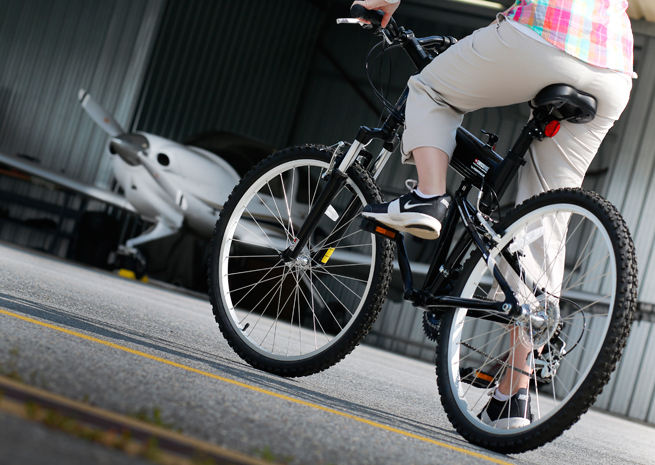
The setup was simple. Grab four bicycle riders from AOPA headquarters, get four folding bicycles, and put each through a series of tests with no prior instruction to the participants. Then sit back and watch the fun.
Through a little cunning research and a little luck, we stumbled upon four unique models—the Strida, Montague X50, Raleigh Folding i8, and Columba 2P26S. The truth is you could pick any four models and pit them against each other and get different results. There are more than 100 folding bike manufacturers in the world, so you have to start somewhere.
 The Strida is the most unusual bike of the bunch. It features a triangle frame, which is odd when you see it set up. But fold it down and the genius becomes readily apparent. The Strida folds pretty much flat, allowing it to be easily stored and shoved into almost anything. It’s also belt-driven, which means no grease inside the airplane. There are lots of cool features, such as the ability to roll it almost like a walking stick with wheels when folded. To store it, simply grab the brake and attach the little cord that hangs from the handlebar. Simple and brilliant. It’s also light, and folds and unfolds faster than any of the competitors.
The Strida is the most unusual bike of the bunch. It features a triangle frame, which is odd when you see it set up. But fold it down and the genius becomes readily apparent. The Strida folds pretty much flat, allowing it to be easily stored and shoved into almost anything. It’s also belt-driven, which means no grease inside the airplane. There are lots of cool features, such as the ability to roll it almost like a walking stick with wheels when folded. To store it, simply grab the brake and attach the little cord that hangs from the handlebar. Simple and brilliant. It’s also light, and folds and unfolds faster than any of the competitors.
Riding it is a different story. Pilots will instantly recognize the inherent instability because of the high center of gravity. Taller riders will find it more comfortable. And while it does take some getting used to, once you get the hang of it the ride is enjoyable.
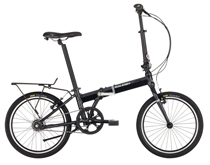 Moving up the tire-size scale is the Raleigh Folding i8. Our riding group loved the Raleigh, as did the throngs of people who tried it around the office. To a person, all commented on the high build quality, great components, and nice ride. The Raleigh also has a nice folding mechanism. The seat, handlebar, frame, and pedals all fold down to make a compact package. All this takes about a minute, and it’s so well built that the folding process is pretty much effortless once you figure it out. The 20-inch tires are a nice compromise between full-size road bike and urban cruiser. Of all the bikes in our test, the Raleigh is probably the nicest and best all-around performer.
Moving up the tire-size scale is the Raleigh Folding i8. Our riding group loved the Raleigh, as did the throngs of people who tried it around the office. To a person, all commented on the high build quality, great components, and nice ride. The Raleigh also has a nice folding mechanism. The seat, handlebar, frame, and pedals all fold down to make a compact package. All this takes about a minute, and it’s so well built that the folding process is pretty much effortless once you figure it out. The 20-inch tires are a nice compromise between full-size road bike and urban cruiser. Of all the bikes in our test, the Raleigh is probably the nicest and best all-around performer.
Of the two full-size bicycles we tried, the Columba 2 2P26S was the runaway favorite. This late entrant to our test is a bit of an unknown, and came to us through a staff member who had purchased it for personal use. With full 26-inch tires, a nice ride, decent components, a kickstand, and an acceptable folding mechanism, the Columba is a good choice.
When you consider the price, however, it’s a winner. For less than $250, including shipping, it comes in at less than half the price of any other model we tested. The only downside we could find was a bulky pivot point on the frame that could catch clothing and legs, although our resident owner didn’t complain of this problem.
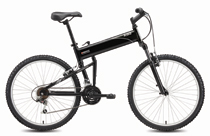 The Montague x50 received a thumbs-up from all our riders, although the overall feeling was one of apathy. While the Montague has a unique and creative folding system, many found the components to be of average quality. The chain needed an adjustment out of the box, and the seat was hard, for example. On the other hand, it does have a nice front shock, great knobby tires for grass riding, and a classic mountain-bike look for those wishing to avoid the folding-bike look. It also comes with a carrying bag, which could be really handy for keeping grease out of the baggage area and off the seats in the airplane.
The Montague x50 received a thumbs-up from all our riders, although the overall feeling was one of apathy. While the Montague has a unique and creative folding system, many found the components to be of average quality. The chain needed an adjustment out of the box, and the seat was hard, for example. On the other hand, it does have a nice front shock, great knobby tires for grass riding, and a classic mountain-bike look for those wishing to avoid the folding-bike look. It also comes with a carrying bag, which could be really handy for keeping grease out of the baggage area and off the seats in the airplane.
After swapping bikes, trading jabs, and riding around in many, many circles, our riders came away generally impressed with all four models. But the biggest surprise of all was that none fit in the baggage area of a Cessna 172. The tires on the Columba and the Montague were too big to fit through the door; the Strida was too long (although to be fair it probably could have fit with some more creative geometry); and the Raleigh was a bit too tall at the frame to slide through. If you have a Bonanza, any of these would fit no problem. But owners of other airplanes may want to check the return policy—or go to the gym in order to be able to lift it over the back seat.
Email [email protected].
DETAILS
Strida: $649
Raleigh Folding i8: $650
Columba 2P26S: www.amazon.com; search “Columba bike;” $189.99
Montague X50: $599
By Jim Moore
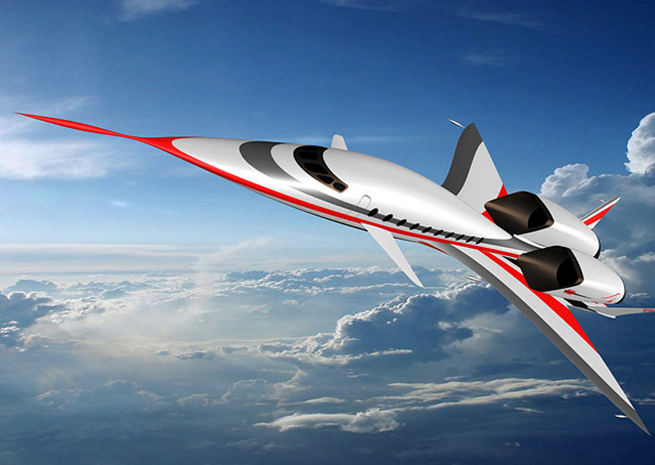
If Richard Lugg has his way, the next generation of supersonic civilian aircraft will shoot through the sky powered by engines that turn out a massive electrical charge, much of it converted into thrust with megawatts left over to silence the sonic boom.
Lugg, a veteran of past NASA efforts to shatter the sound barrier, founded HyperMach Aerospace Industries and SonicBlue Aerospace, which have worked quietly for more than a decade to refine designs aimed at near-silent supersonic flight—one focused on the airframe, and the other building the powerplant.
Building an aircraft that can turn New York to Tokyo into a two-hour trip remains an elusive and coveted goal. To make such an aircraft economically feasible, it must have engines that push it faster than the Concorde on a fraction of the fuel.
The engine would incorporate turbine stages not connected by a shaft, each able to rotate independently at the optimal speed for maximum aerodynamic efficiency in flight. They would spin in electromagnetic fields, using the same principle that allows high-speed trains to float frictionless above an energized track. The engine is a hybrid of turbofan, turbojet, and turbo ramjet, able to generate 40 megawatts (MW) of electricity. It uses about 9 MW of electricity to power a plasma field generator reshaping airflow around the aircraft and taming the pressure wave, turning sonic boom into a sound similar to rustling leaves on the ground.
Email [email protected].
Mach 4 at 62,000 feet
SonicStar is the first concept aircraft to take shape that will utilize the patented Magnetic Advanced Generation Jet Electric Turbine (MAGJET) system, which has evolved into supersonic and hypersonic variations (S-MAGJET and H-MAGJET). SonicStar is a design with visual similarities to concepts being developed by Aerion Corp. That and other efforts are funded in part by NASA, which is also collaborating with Boeing.
SonicStar has upped the ante from Mach 3.3 to Mach 4 at 62,000 feet, edging toward the top end of the supersonic speed range (hypersonic speeds begin at Mach 5). The final engine design may run on traditional jet fuel formulations, or hydrogen, which would yield virtually emission-free performance. That and many other questions remain to be resolved.
Lugg hopes SonicStar will be ready for certification in 2023, though much of the technology still needs to be refined and perfected for that to happen.
SonicStar is not the only aircraft Richard Lugg has in mind: He also plans to produce a suborbital Transport-clategory aircraft using another hybrid engine technology.
“We’ve got our hands full, we’re very much aware of that,” Lugg said.
All-new website debuts
AOPA enhancing online presence, member interactions
By Alyssa J. Miller
 AOPA is transitioning to a redesigned website and a new membership management system in an effort to enhance member interaction with the association online. The new design and technologies are geared to make it easier for members to find aviation information and update membership profile and benefits any time, any day, from any computer or mobile device.
AOPA is transitioning to a redesigned website and a new membership management system in an effort to enhance member interaction with the association online. The new design and technologies are geared to make it easier for members to find aviation information and update membership profile and benefits any time, any day, from any computer or mobile device.
The redesigned website went live May 29 and features new, user-friendly navigation; quick links to AOPA’s popular flight planning tools; a dedicated news page; an advocacy alert section to keep you abreast of the association’s efforts to protect your freedom to fly and grow the pilot population; a consolidated AOPA Store for one-stop shopping; and easy-to-find information and forms on topics from buying an aircraft to medical certification to international flight operations. The popular online courses, quizzes, and informational webinars and webcasts from the AOPA Foundation’s Air Safety Institute are bundled in one location for you to peruse, similar to movie listings on the Netflix website.
“AOPA members tell us the website is an important member benefit, and after thorough research of how our members use the site and best practices, we have redesigned the website to make it easier for you to quickly navigate to the information you need,” said Michelle Peterson, AOPA vice president of membership. “The site will offer new functionality including optimization for mobile devices. More importantly, it creates a new technology infrastructure that will allow us to deploy numerous other features quickly. Look for those later this year.”
The new membership management system, expected to be up this summer, will make it easier for you update your membership, manage your print and online subscriptions, enroll in programs to help you finance or insure your aircraft, seek medical or legal assistance, purchase products, and even print a new certificate for the online safety courses you have completed.
“You can rest easy knowing that your personal information will continue to be secure with AOPA, as we seek to stay technologically current and follow best practices,” said Doug Shorter, AOPA chief information officer and vice president of information and technology.
AOPA’s Member Services and Pilot Information Center specialists are and will continue to be available to help you one-on-one over the phone through our toll-free hotline (800-USA-AOPA) or via email.
“We know that change, especially with new designs and technologies, doesn’t occur without a few glitches,” Peterson said. “We hope you will agree these small inconveniences are worth it to ensure membership records are properly maintained, business transactions are supported, and communication with you is more efficient. Making this move as seamless for you as possible is very important to us. We encourage you to contact us with any problems that you encounter while visiting our website or trying to manage your membership profile online.”
To that end, AOPA’s specialists have received extensive training with both of the new systems and are eager to help you with any questions you may encounter. They are standing by Monday through Friday, 8:30 a.m. to
8 p.m. Eastern time.
Email [email protected].
HondaJet CEO confident in light jet market
By Thomas B. Haines
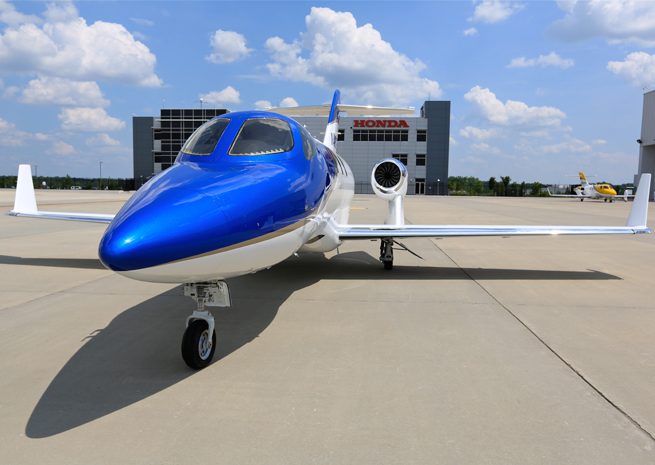
While challenged by engine flight test problems and a struggling economy, the president and CEO of Honda Aircraft remains optimistic that his light jet will be the right airplane at the right time. In an exclusive interview with AOPA Live This Week from the European Business Aviation Convention and Exhibition (EBACE) in Geneva, Switzerland, Michimasa Fujino acknowledged the world economy is quite different than when the proof-of-concept HondaJet first flew in December 2003. But the first flight in mid-May of the fifth conforming airplane is “a big milestone for us, and a first flight is emotional for us, too,” he said. The last of the conforming airplanes taking to the air is the beginning of the end of the airplane’s long testing program.
Number five will be used for function and reliability testing. Equipped with a production interior, a standard lavatory, and numerous options, the airplane will be used to fine-tune all of the things a customer uses and touches on the airplane and prove the reliability of the systems. “From inside and out, this HondaJet matches the final configuration of a customer aircraft,” Fujino said after the first flight. “Our flight test fleet maintains a very active schedule and continues to complete milestones for FAA certification flight testing.”
Fujino described the recently announced one-year delay of HondaJet customer deliveries as “very unfortunate.” Several problems have led to numerous delays of the GE Honda Aero Engines HF120 turbofans. Fujino said he plans to use the delay to fine-tune process improvements on the jet production line. With aircraft certification now planned for late 2014, he hopes to ramp up quickly to deliver the more than 100 HondaJets on order.
Meanwhile, work on the customer service center at the company headquarters in Greensboro, North Carolina, continues. That facility will serve as a heavy maintenance site capable of doing extensive composite repairs. Seven dealer locations in North America and three more in Europe will provide additional service support.
Despite the economic challenges of recent years, Fujino is confident that a U.S. gross domestic product growth in the range of 3.2 percent will spur business jet sales growth of four percent over the coming decade—a growth rate that may increase if the federal government implements more favorable tax policies. “If we provide a high-efficiency product and low-cost transportation, I think there is still a good potential demand for the light business jet market,” he said.
Email [email protected].
